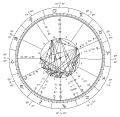Tibetan astrology
Appearance
Tibetan astrology (Tibetan: དཀར་རྩིས, Wylie: dkar rtsis) is a traditional discipline of the Tibetan peoples that has dialogued with both Chinese astrology and Indian astrology. Tibetan astrology is one of the 'Ten Sciences' (Wylie: rig-pa'i gnas bcu; Sanskrit: daśavidyā) in the enumeration honoured by this cultural tradition.[1]
Year-signs
The Year-signs cycle in an archetypal progression or continuüm:
| Gregorian year | Tibetan year | Losar* | element and animal |
|---|---|---|---|
| 2000 | 2127 | February 5 – February 7 | iron Dragon (male) |
| 2001 | 2128 | January 24 – January 26 | iron Snake (female) |
| 2002 | 2129 | February 12 – February 14 | water Horse (male) |
| 2003 | 2130 | February 1 – February 3 | water Goat (female) |
| 2004 | 2131 | January 22 – January 24 | wood Monkey (male) |
| 2005 | 2132 | February 9 – February 11 | wood Rooster (female) |
| 2006 | 2133 | January 30 – February 1 | fire Dog (male) |
| 2007 | 2134 | February 18 – February 20 | fire Pig (female) |
| 2008 | 2135 | February 8 – February 10 | earth Rat (male) |
| 2009 | 2136 | January 27 – January 29 | earth Ox (female) |
| 2010 | 2137 | February 12 - February 14 | iron Tiger (male) |
- * Note: The start date of Losar depends on what time zone one is in. For example, in 2005, Losar started on February 8 in U.S. time zones and February 9 in Asia time zones. Some people began celebrating Losar on February 9 in the US. The Tibetan new year is based on a fluctuating point that marks the New Moon that is nearest to the beginning of February. It is important to note that, despite their apparent similarities, the start of the TIbetan and Chinese New Years can sometimes differ by a whole month.
Vaiḍūrya dKar-po (White Beryl)
The names of the chapters of the Vaiḍūrya dKar-po (the premier Tibetan text on astrological divination) are :
- 1. "Aspects of Turtle Divination"
- 2. "Hidden Points"
- 3. "Geomantic Aspects"
- 10. "The Thirty Computational Charts"
- 11. "The Thirteen Charts"
See also
- Jyotisha (Indian astrology)
- Chinese astrology
- Losar
- Tibetan calendar
- Culture of Tibet
- Tibetan people
- Tibet
- Tibet Autonomous Region
Notes
- ^ Dudjom Rinpoche and Jikdrel Yeshe Dorje. The Nyingma School of Tibetan Buddhism: its Fundamentals and History. Two Volumes. 1991. Translated and edited by Gyurme Dorje with Matthew Kapstein. Wisdom Publications, Boston. ISBN 0-86171-087-8; Enumerations p.167
- ^ http://ahmc.ngalso.net/2014/01/28/tibetan-astrology-table-of-year-animal-element-2/?lang=en
- ^ http://ahmc.ngalso.net/2014/01/28/tibetan-astrology-table-of-year-animal-element-2/?lang=en
Further reading
- Cornu, Philippe Tibetan Astrology. Shambhala, 1997. ISBN 1-57062-217-5.
- Desi Sangye Gyatso, Lochen Dharmasri and Gyurme Dorje White Beryl: Tibetan Elemental Divination Paintings. Eskenazi, 2001. ISBN 0-9539941-0-4
- Berzin, A. Tibetan Astrology and Astronomy. in Maitreya Magazine (Emst, Holland), vol. 11, no. 4 (1989).
- Berzin, A. Tibetan Astro Studies. in Chö-Yang, Year of Tibet Edition (Dharamsala, India), (1991).
- Namkhai Norbu Rinpoche Key for Consulting the Tibetan Calendar. Shang Shung Edizioni, 2003.
External links
- བོད་གཞུང་སྨན་རྩི་ཁང་། Men-Tsi-Khang Institute of Medicine & Astrology of H.H. the Dalai Lama, Dharamsala India.
- The Tibetan Astrology Network
- Tibetan Astro Sciences: Basic Principles - Dr. Alexander Berzin
- Digital Tibetan Buddhist Altar See the "Weekly Tibetan Astrology" feature and related background resources. Includes extensive information on yearly Tibetan astrology, inclusive of moving elements, spirits, parkha and mewa.

